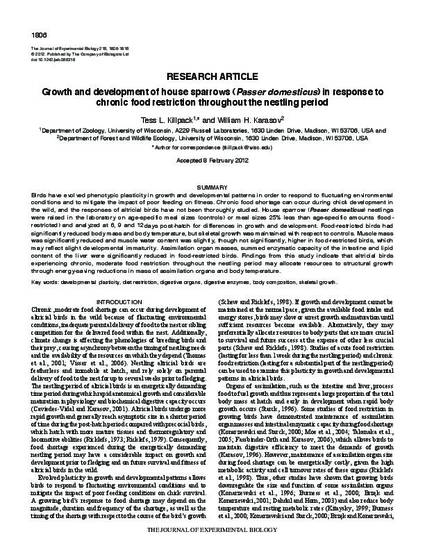
Article
Growth and development of house sparrows ( Passer domesticus ) in response to chronic food restriction throughout the nestling period
The Journal of Experimental Biology
(2012)
Abstract
Birds have evolved phenotypic plasticity in growth and developmental patterns in order to respond to fluctuating environmental conditions and to mitigate the impact of poor feeding on fitness. Chronic food shortage can occur during chick development in the wild, and the responses of altricial birds have not been thoroughly studied. House sparrow (Passer domesticus) nestlings were raised in the laboratory on age-specific meal sizes (controls) or meal sizes 25% less than age-specific amounts (foodrestricted) and analyzed at 6, 9 and 12days post-hatch for differences in growth and development. Food-restricted birds had significantly reduced body mass and body temperature, but skeletal growth was maintained with respect to controls. Muscle mass was significantly reduced and muscle water content was slightly, though not significantly, higher in food-restricted birds, which may reflect slight developmental immaturity. Assimilation organ masses, summed enzymatic capacity of the intestine and lipid content of the liver were significantly reduced in food-restricted birds. Findings from this study indicate that altricial birds experiencing chronic, moderate food restriction throughout the nestling period may allocate resources to structural growth through energy-saving reductions in mass of assimilation organs and body temperature.
Publication Date
June, 2012
DOI
10.1242/jeb.066316
Citation Information
Tess L. Killpack and William H. Karasov. "Growth and development of house sparrows ( Passer domesticus ) in response to chronic food restriction throughout the nestling period" The Journal of Experimental Biology Vol. 215 Iss. 11 (2012) p. 1806 - 1815 Available at: http://works.bepress.com/tess-killpack/9/
